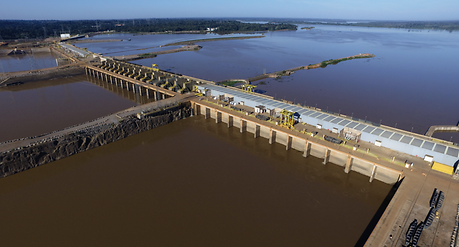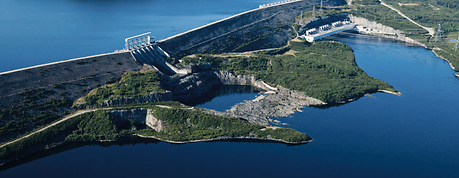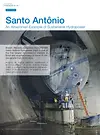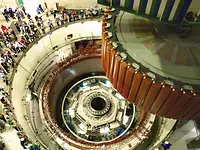La Grande 3 & 4 - Canada
Santo Antônio
An Amazonian Example of Sustainable Hydropower, Brazil
Recently completed, the 3,568 MW Santo Antônio hydropower plant is one of the five largest hydroelectric station in Brazil and supplies energy to some 44 million people from its 50 units.

World’s largest bulb turbine being installed at Santo Antônio

Installation works

Powerhouse and dam area
Antônio de Pádua Bemfica Guimarães is technical director of Santo Antônio Energia (SAE), a company responsible for implementation of Santo Antônio, he talked to Hydro News about the project.
What makes the bulb turbines at HPP Santo Antônio special?
HPP Santo Antônio uses the largest bulb turbines in the world. The previous record-holder uses machines rated at 68 MW, our turbines have 71.6 MW. In terms of size, at 7,500 mm diameter they are second only to the 8,410 mm units installed at HPP Murray Lock, in the USA.
The decision to use bulb turbines was driven by the flow characteristics of the Madeira River and the necessity to minimize the environmental impact of a large project, significantly reducing the area of the reservoir. Precisely because it is a run-of-river power plant, the bulb turbine proved the best solution to combine lowest impacts with highest use of the hydroelectric potential of the river.
What were your main considerations in selecting the key contractors for Santo Antônio?
Due to the project complexity, a lot of equipment involved, and the size of the turbine set for the Santo Antônio hydropower plant, the supply chain was concentrated in the most experienced and largest power generation equipment manufacturers. In addition, the Santo Antônio project implementation is under an EPC (Engineering Procurement and Construction) contract structure.
ANDRITZ HYDRO is part of the Santo Antônio Constructor Consortium (CCSA). Its scope of supply included; 14 bulb turbines, 13 generators, 28 excitation systems, 26 generator switchgear systems, and three power transformers rated at 13.8 kV-500 kV.
The companies that make up the CCSA had, in addition to their expertise, an important role in the development of local companies and service providers. This partnership is leaving an important legacy because they prepared local companies to meet the demands of other projects.
What unexpected challenges have arisen during the construction and installation of Santo Antônio?
Many adverse situations have arisen during the implementation phase of the Santo Antônio hydroelectric plant. Two of them deserve to be highlighted:
The high concentration of sediments carried by the Madeira River, which reaches 500 million tons/year; and, the large amount of floating elements during the flood season, which add up to about 30,000 logs, antlers and other objects a day.
Construction, erection, and commissioning activities took place simultaneously with operating activities so while generation units were being installed many problems were identified in the units that were in commercial operation. This required a continuous reassessment of the project and often further studies.

Antônio de Pádua Bemfica Guimarães is technical director of the Santo Antônio Energia (SAE) Company, responsible for implementation of the Santo Antônio hydropower project on the Madeira River in Porto Velho, the capital of the northwestern Brazilian state of Rondônia.
A civil engineer, since graduating in 1980 he has held senior roles in Enerpeixe and Furnas Centrais Elétrica. Today, Antônio de Pádua is responsible for the EPC Contract Management and construction inspections on this giant project...
Given its location in the Amazon, how does Santo Antônio address environmental sustainability concerns?
The Amazon is a sensitive area, with strict environmental preservation standards. Therefore, it is essential to adopt practices that minimize to the maximum the effects that large infrastructure projects, such as hydroelectric dams, can cause in a region like the Amazon. One way to ensure this is to allocate financial resources and apply techniques and appropriate technologies to mitigate these effects, compensating for the impacts caused.
The Basic Environmental Project (PBA) is a document that describes the set of actions and measures to be implemented before, during and after the works of our hydroelectric installation. Despite the name, it does not cover only environmental initiatives. The recovery and strengthening of the history and culture of Porto Velho, as well as the enhancement and development of the local population, are vectors of sustainability that are also part of our company project. In total, 28 programs have been conducted and add great results.
Regarding social and environmental concerns in the country, the Santo Antônio hydropower plant is a good example for implementation of sustainable power generation models. Strictly respecting the rules established by the Brazilian environmental agencies, the project was designed to respect the natural characteristics of Amazonia, at the same time taking the maximum advantage of the Madeira’s hydraulic potential.
An evaluation made by the IHA – International Hydropower Association, considered Santo Antônio the most sustainable project evaluated by them in the world, achieving the highest number of top marks in more than 20 topics related to environmental issues and stakeholders influenced by the project.
How do you see future hydropower development in the Amazon region of Brazil unfolding?
The Amazon is the last frontier of the country's hydropower generation development, with about 70% of its potential yet to be explored. Given this, it is natural that there is a strategic interest in making the region an important hub of clean and renewable power generation, attracting large projects. Today, using the Santo Antônio hydropower plant as an example, you realize that you can explore all this power responsibly, incorporating the new project mechanisms that significantly reduce the environmental impact and ensure the use of the Amazon’s potential. The implementation of Santo Antônio is an important benchmark for other projects planned for the region, especially in breaking the old paradigm. It is possible to generate energy from the Amazon with sustainability.
Joining knowledge and the sum of the technical experience of the team of Santo Antônio Energia, ANDRITZ HYDRO and other manufacturers, we are certainly making history in the implementation of large infrastructure projects, and helping to avoid imperfections in future projects.
Santo António in short
Part of the Madeira River Complex 3,568 MW installed capacity 50 units in operation since November 2016 71.6 MW world's largest bulb turbines 7,500 mm runner diameter, among the largest worldwide 2.5 km dam length – The amount of steel and concrete used correspond to |




